2010 Lexus ES350 run flat
[x] Cancel search: run flatPage 11 of 543
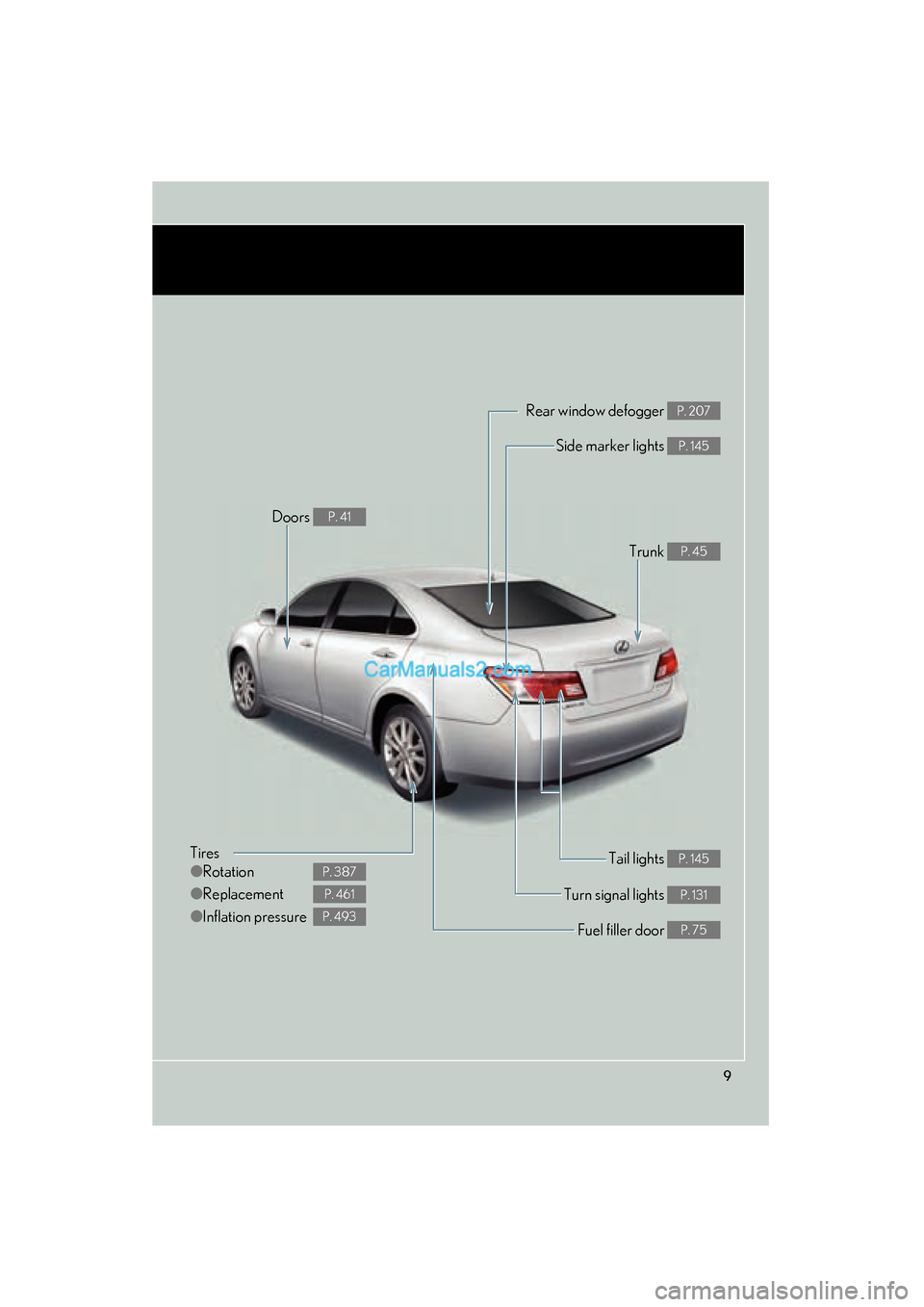
ES350_U
9
Tires
●Rotation
● Replacement
● Inflation pressure
P. 387
P. 461
P. 493
Tail lights P. 145
Side marker lights P. 145
Trunk P. 45
Rear window defogger P. 207
Doors P. 41
Fuel filler door P. 75
Turn signal lights P. 131
Page 366 of 543

364
4-2. Maintenance
ES350_U
Vehicle exterior
ItemsCheck points
Steering wheel
• Moves smoothly?
• Has correct free play?
• No strange noises?
ItemsCheck points
Door/trunk• Operate smoothly?
Engine hood• The lock system works properly?
Fluid leaks• Is there any leakage after parking?
Ti r e
• Inflation pressure is correct?
• Tire surfaces not worn or dam-aged?
• Tires rotated according to the maintenance schedule?
• Wheel nuts are not loose?
CAUTION
■If the engine is running
Turn the engine off and ensure that there is adequate ventilation before performing
maintenance checks.
Page 431 of 543
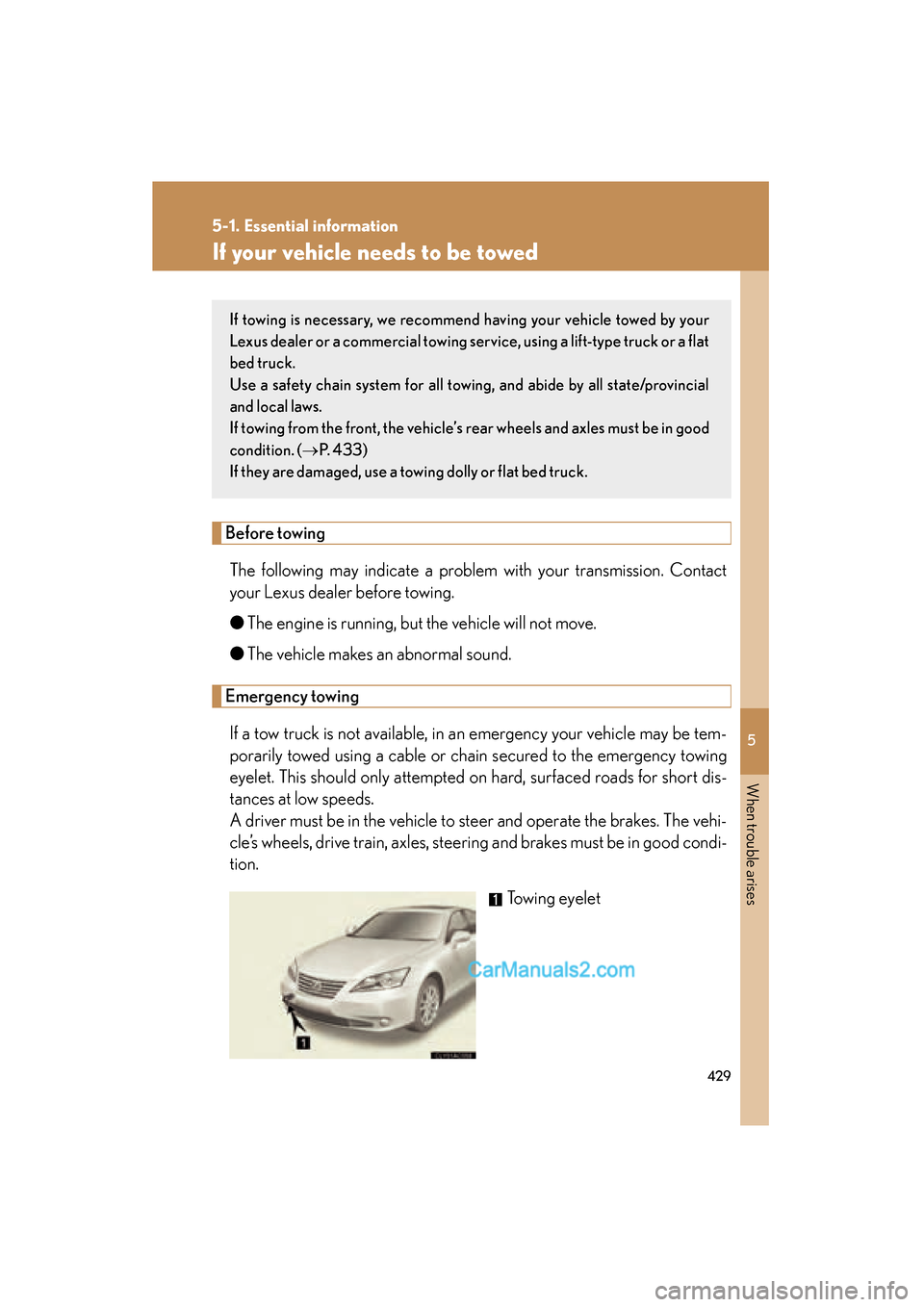
5
When trouble arises
429
5-1. Essential information
ES350_U
If your vehicle needs to be towed
Before towingThe following may indicate a problem with your transmission. Contact
your Lexus dealer before towing.
● The engine is running, but the vehicle will not move.
● The vehicle makes an abnormal sound.
Emergency towing
If a tow truck is not available, in an emergency your vehicle may be tem-
porarily towed using a cable or chain secured to the emergency towing
eyelet. This should only attempted on hard, surfaced roads for short dis-
tances at low speeds.
A driver must be in the vehicle to steer and operate the brakes. The vehi-
cle’s wheels, drive train, axles, steering and brakes must be in good condi-
tion. Towing eyelet
If towing is necessary, we recommend having your vehicle towed by your
Lexus dealer or a commercial towing se rvice, using a lift-type truck or a flat
bed truck.
Use a safety chain system for all towing, and abide by all state/provincial
and local laws.
If towing from the front, the vehicle’s rear wheels and axles must be in good
condition. ( �oP. 4 3 3 )
If they are damaged, use a towing dolly or flat bed truck.
Page 432 of 543
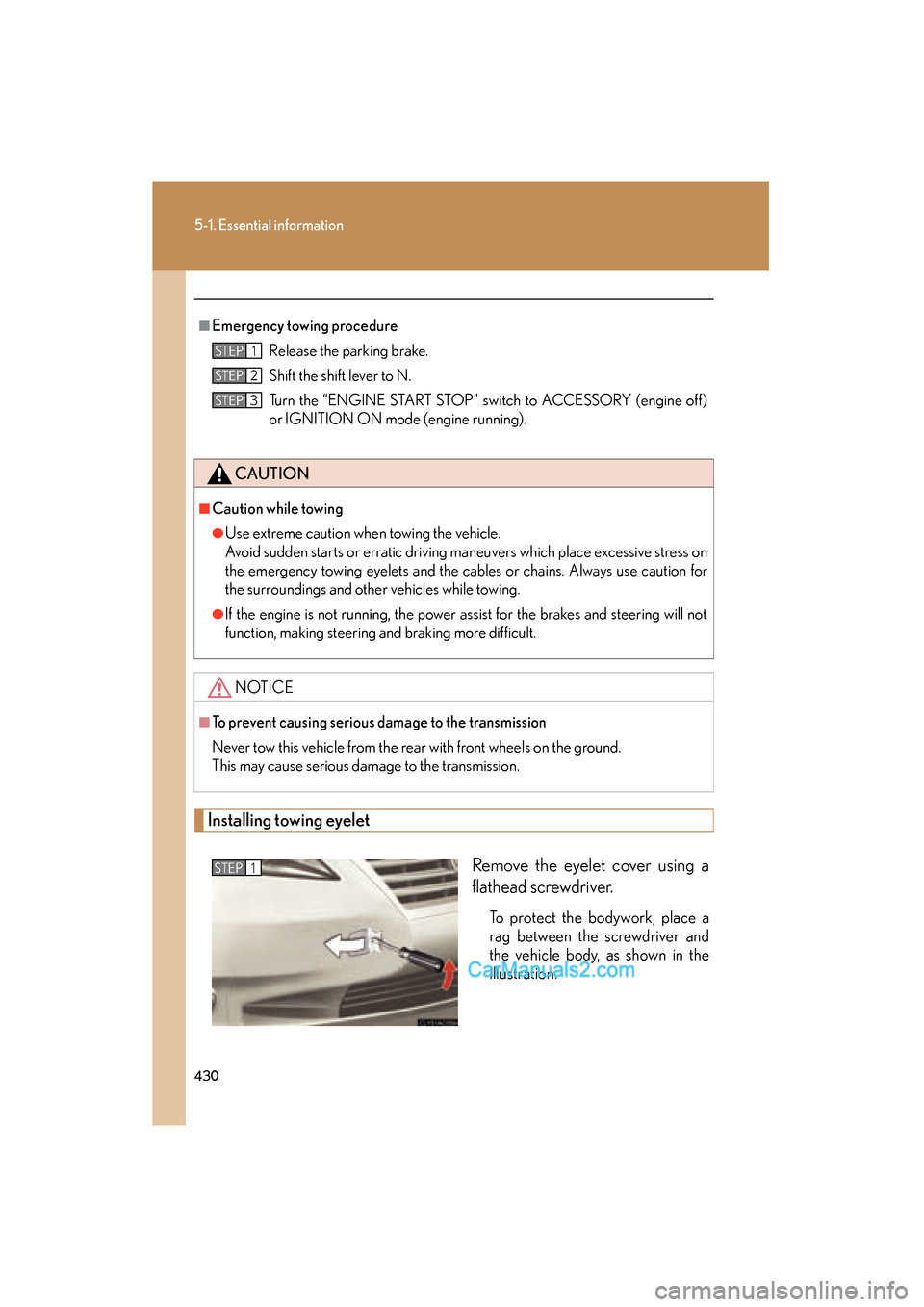
430
5-1. Essential information
ES350_U
Installing towing eyeletRemove the eyelet cover using a
flathead screwdriver.
To protect the bodywork, place a
rag between the screwdriver and
the vehicle body, as shown in the
illustration.
■Emergency towing procedureRelease the parking brake.
Shift the shift lever to N.
Turn the “ENGINE START STOP” switch to ACCESSORY (engine off)
or IGNITION ON mode (engine running).
CAUTION
■Caution while towing
●Use extreme caution when towing the vehicle.
Avoid sudden starts or erratic driving maneuvers which place excessive stress on
the emergency towing eyelets and the cables or chains. Always use caution for
the surroundings and other vehicles while towing.
●If the engine is not running, the power assist for the brakes and steering will not
function, making steering and braking more difficult.
NOTICE
■To prevent causing serious da mage to the transmission
Never tow this vehicle from the rear with front wheels on the ground.
This may cause serious damage to the transmission.
STEP1
STEP2
STEP3
STEP1
Page 437 of 543
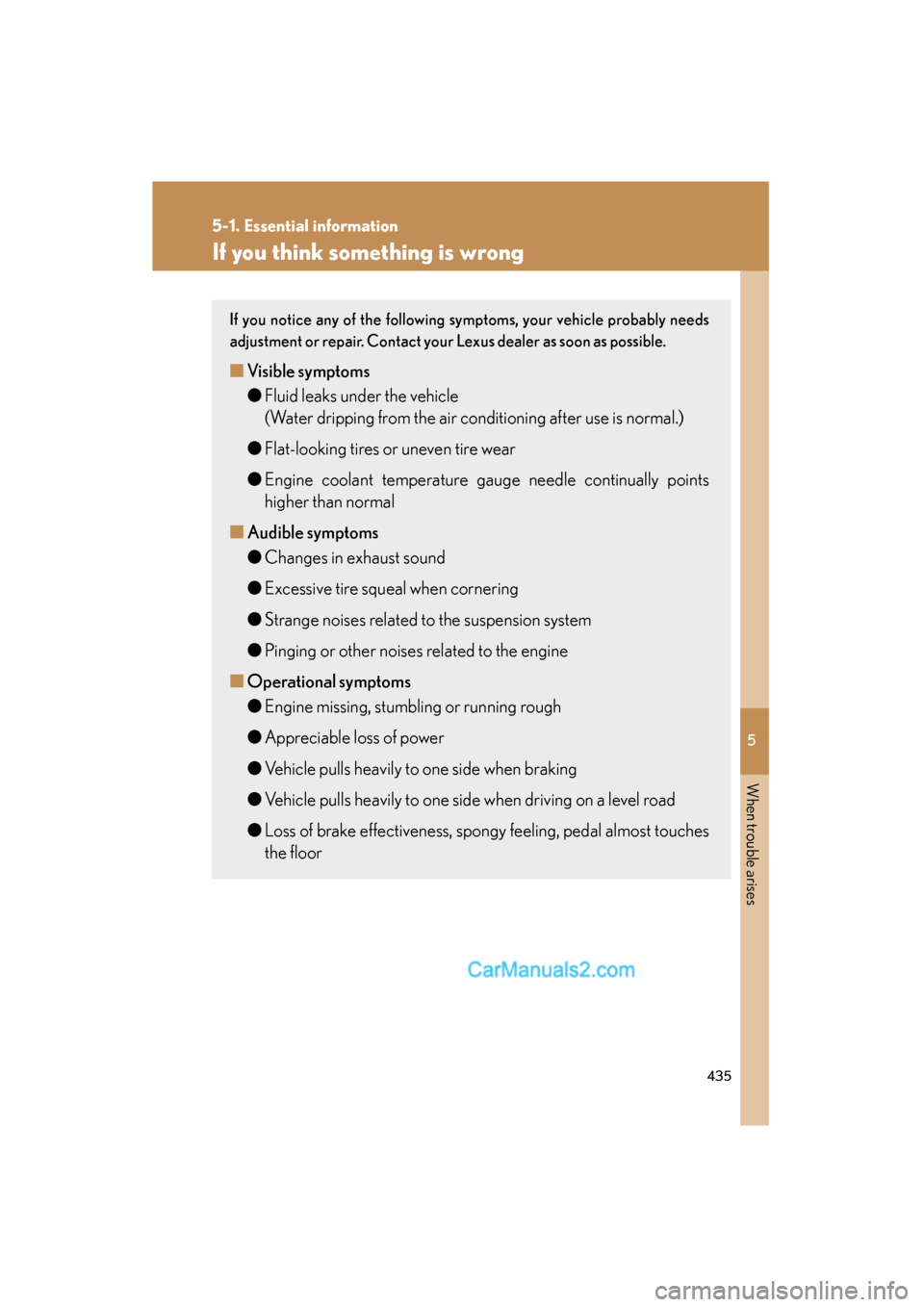
5
When trouble arises
435
5-1. Essential information
ES350_U
If you think something is wrong
If you notice any of the following symptoms, your vehicle probably needs
adjustment or repair. Contact your Lexus dealer as soon as possible.
■Visible symptoms
●Fluid leaks under the vehicle
(Water dripping from the air conditioning after use is normal.)
● Flat-looking tires or uneven tire wear
● Engine coolant temperature gauge needle continually points
higher than normal
■ Audible symptoms
●Changes in exhaust sound
● Excessive tire squeal when cornering
● Strange noises related to the suspension system
● Pinging or other noises related to the engine
■ Operational symptoms
●Engine missing, stumbling or running rough
● Appreciable loss of power
● Vehicle pulls heavily to one side when braking
● Vehicle pulls heavily to one side when driving on a level road
● Loss of brake effectiveness, spongy feeling, pedal almost touches
the floor
Page 447 of 543
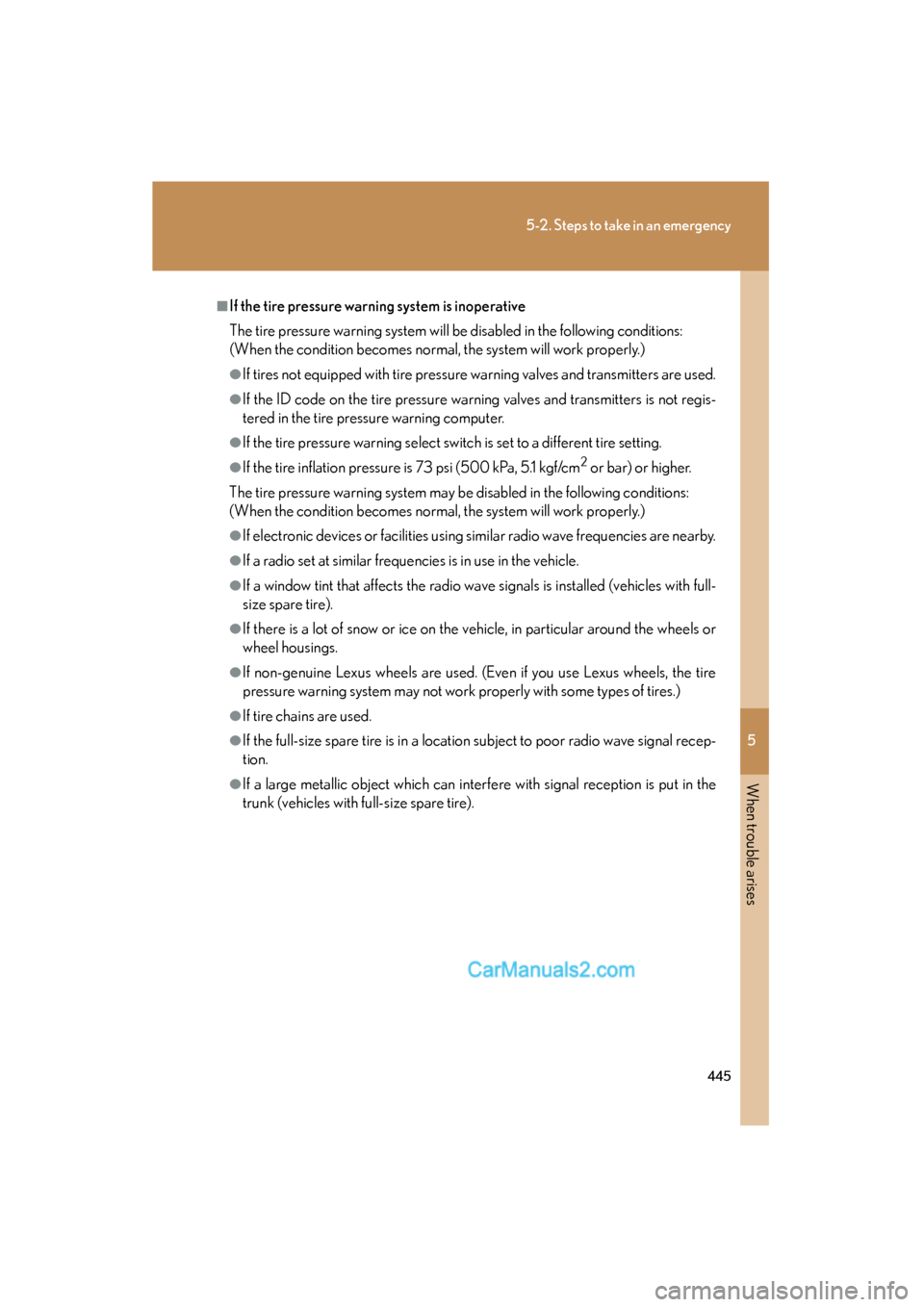
5
When trouble arises
445
5-2. Steps to take in an emergency
ES350_U
■If the tire pressure warning system is inoperative
The tire pressure warning system will be disabled in the following conditions:
(When the condition becomes normal, the system will work properly.)
●If tires not equipped with tire pressure warning valves and transmitters are used.
●If the ID code on the tire pressure warning valves and transmitters is not regis-
tered in the tire pressure warning computer.
●If the tire pressure warning select switch is set to a different tire setting.
●If the tire inflation pressure is 73 psi (500 kPa, 5.1 kgf/cm2 or bar) or higher.
The tire pressure warning system may be disabled in the following conditions:
(When the condition becomes normal, the system will work properly.)
●If electronic devices or facilities using similar radio wave frequencies are nearby.
●If a radio set at similar frequencies is in use in the vehicle.
●If a window tint that affects the radio wave signals is installed (vehicles with full-
size spare tire).
●If there is a lot of snow or ice on the vehicle, in particular around the wheels or
wheel housings.
●If non-genuine Lexus wheels are used. (Even if you use Lexus wheels, the tire
pressure warning system may not work properly with some types of tires.)
●If tire chains are used.
●If the full-size spare tire is in a location subject to poor radio wave signal recep-
tion.
●If a large metallic object which can interfere with signal reception is put in the
trunk (vehicles with full-size spare tire).
Page 470 of 543

468
5-2. Steps to take in an emergency
ES350_U
CAUTION
■Using the tire jack
Improper use of the tire jack may lead to death or serious injuries due to the vehicle
suddenly falling off the jack.
●Do not use the tire jack for any purpose other than replacing tires or installing and
removing tire chains.
●Only use the tire jack that comes with this vehicle for replacing a flat tire.
Do not use it on other vehicles, and do not use other tire jacks for replacing tires
on this vehicle.
●Always check that the tire jack is securely set to the jack point.
●Do not put any part of your body under the vehicle supported by a jack.
●Do not start or run the engine while your vehicle is supported by the jack.
●Do not raise the vehicle while someone is in it.
●When raising the vehicle, do not put an object on or under the jack.
●Do not raise the vehicle to a height greater than that required to replace the tire.
●Use a jack stand if it is necessary to get under the vehicle.
Take particular care when lowering the vehicle to ensure that no one working on or
near the vehicle may be injured.
■Replacing a flat tire
Observe the following precautions to reduce the risk of death or serious injury.
●Never use oil or grease on the wheel bolts or wheel nuts.
Oil and grease may cause the wheel nuts to be excessively tightened, leading to
bolt or disc wheel damage. In addition, the oil or grease can cause the wheel nuts
to loosen and the wheel may fall off, causing a serious accident. Remove any oil or
grease from the wheel bolts or wheel nuts.
●Have the wheel nuts tightened with a torque wrench to 10.5 kgf•m (103 N•m, 76
ft•lbf) as soon as possible after changing wheels.
Failure to follow these precautions could cause the nuts to loosen and the wheels
may fall off, which could lead to an accident causing death or serious injury.
Page 532 of 543

530
Alphabetical index
ES350_U
Cooling systemEngine overheating ......................... 480
Cornering assist sensors .................... 165
Cruise control Cruise control .......................................152
Dynamic radar crui se control ...... 155
Cup holders ............................................. 315
Curtain shield airbags............................85
Customizable features ..........................511
Daytime running light system ........... 146
Defogger Rear window........................................ 207
Side mirror ............................................ 207
Dimension ................................................486
Dinghy towing ......................................... 197
Display Dynamic radar crui se control ...... 155
Trip information ......................................141
Warning message............................. 449
Do-it-yourself maintenance .............366
Door courtesy lights Door courtesy lights........................ 308
Wattage.................................................. 495
Doors Door glasses ........................................... 68
Door lock.................................. 26, 38, 41
Side mirrors ............................................. 66
Driver's seat belt reminder light ...... 441
Driving Break-in tips ............................................. 117
Correct posture .................................... 83
Procedures .............................................. 116
Winter driving tips.............................. 184
Driving position memory ......................50 Electronic key
If the electronic key does not
operate properly.............................475
Emergency, in case of
If the electronic key does not operate properly.............................475
If the engine will not start ................. 471
If the shift lever cannot be shifted from P....................................473
If the vehicle has discharged
battery .................................................. 477
If the warning buzzer sounds...... 439
If the warning light turns on.......... 439
If the warning message is
displayed ............................................ 449
If you have a flat tire .......................... 461
If you lose your keys ......................... 474
If you think something is
wrong .................................................. 435
If your vehicle becomes stuck .... 483
If your vehicle needs to be towed ....................................................429
If your vehicle overheats................480
Emergency flashers
Switch...................................................... 428
Engine
Compartment ......................................373
Engine switch ........................................ 124
Hood ....................................................... 370
How to start the engine ................... 124
Identification number ...................... 487
If the engine will not start ................. 471
Ignition switch ....................................... 124
Overheating ........................................480
Engine compartment cover ............. 374
D
E